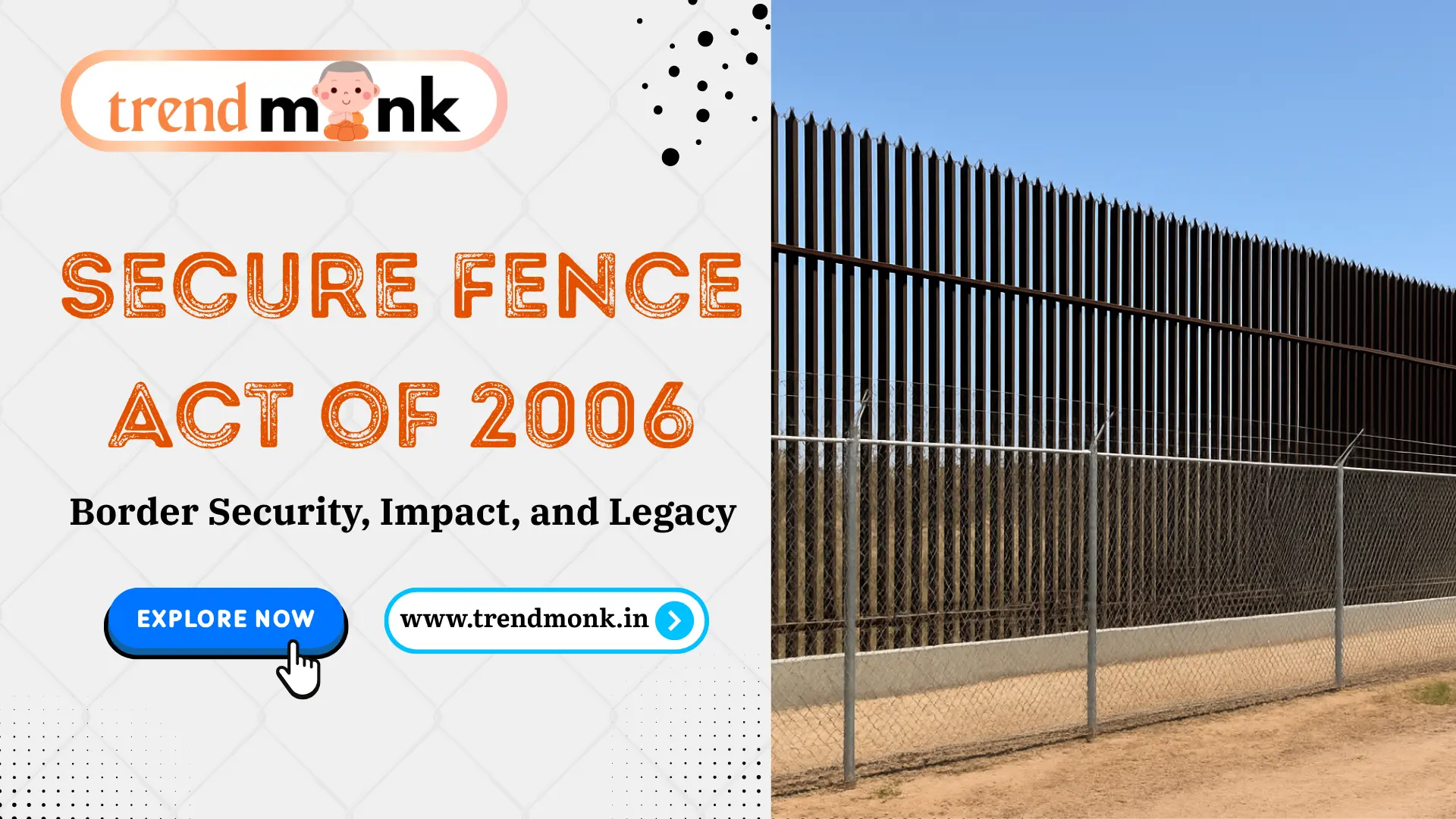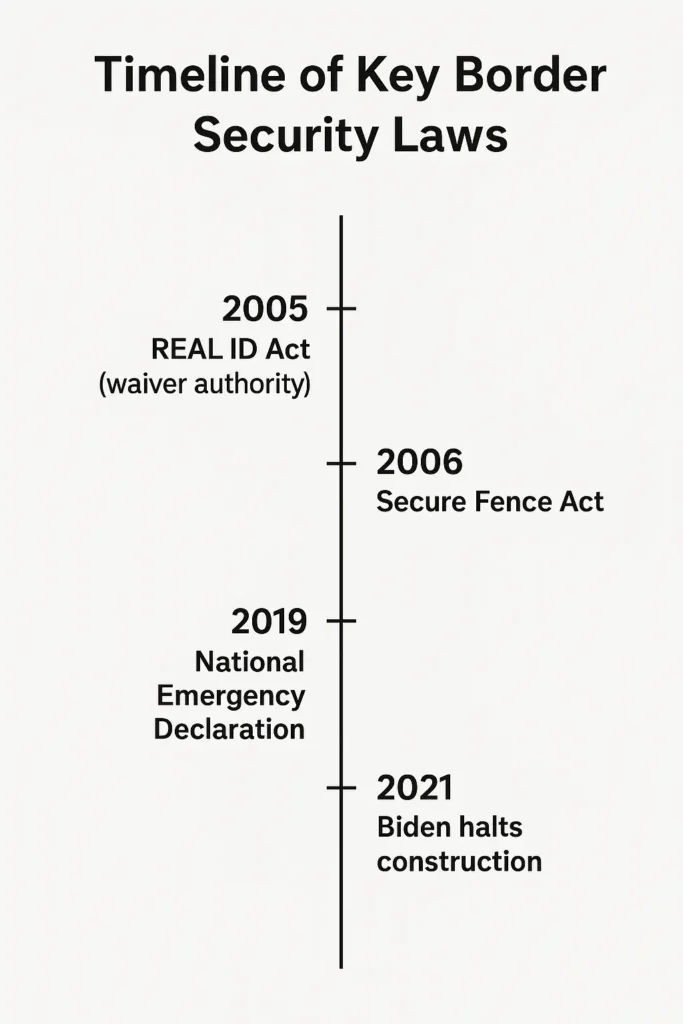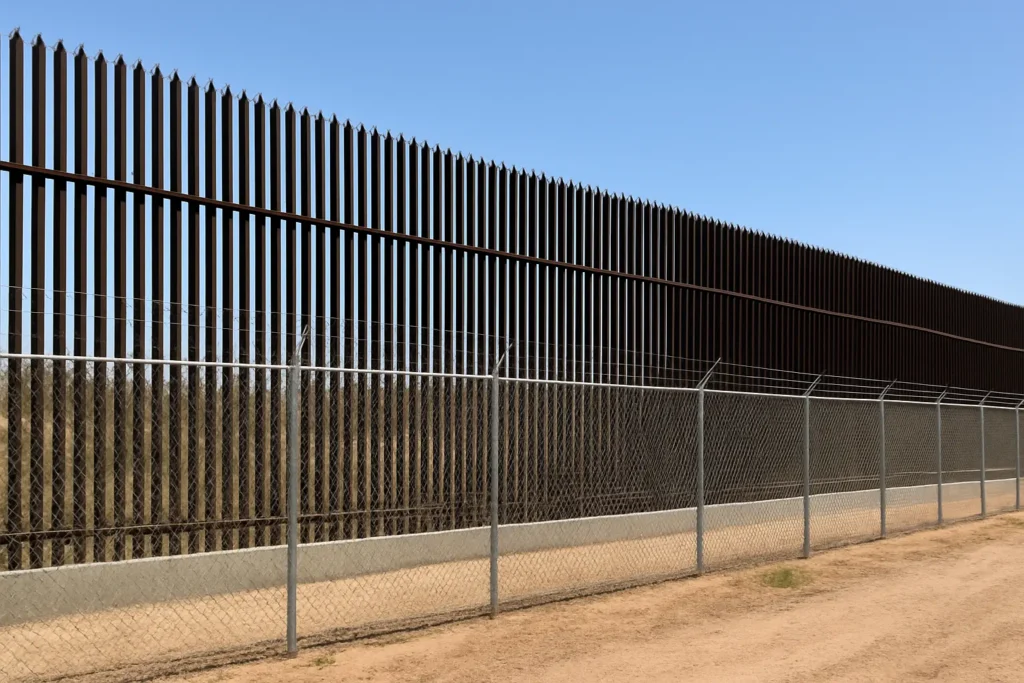Objectives and Coverage of the 2006 Secure Fence Act
Following the increasing national sensitivities regarding border security, illegal immigration into the country, and homeland security, the United States Congress legislated the Secure Fence Act of 2006, which is an historic bill to strengthen the U.S. and Mexico border. The act, which was signed into law by President George Signed by President George WBush on October 26, 2006, the Secure Fence Act marked a pivotal moment in the evolution of US border security policy. Bush and it allowed the fencing of 700 miles of the southern border, fitted with high-tech surveillance equipment and several thousand more personnel.
In this illustrious blog, we will explore a detailed account of the Secure Fence Act (2006) including history behind the legislation, the legislative aspects, the challenges involved in its enforcement, legal criticisms, and an account of why the law, despite its questionable nature among those who oppose it, remains relevant today in political and security processes. We will also take a look at its fit in larger U.S. efforts at immigration reform as well as a path ahead towards better border protection.
As a student, a policymaker, a journalist, or a concerned citizen this detailed examination of a major facet of law on border security in modern American history will offer you authoritative knowledge on this incisively important piece of legislation.
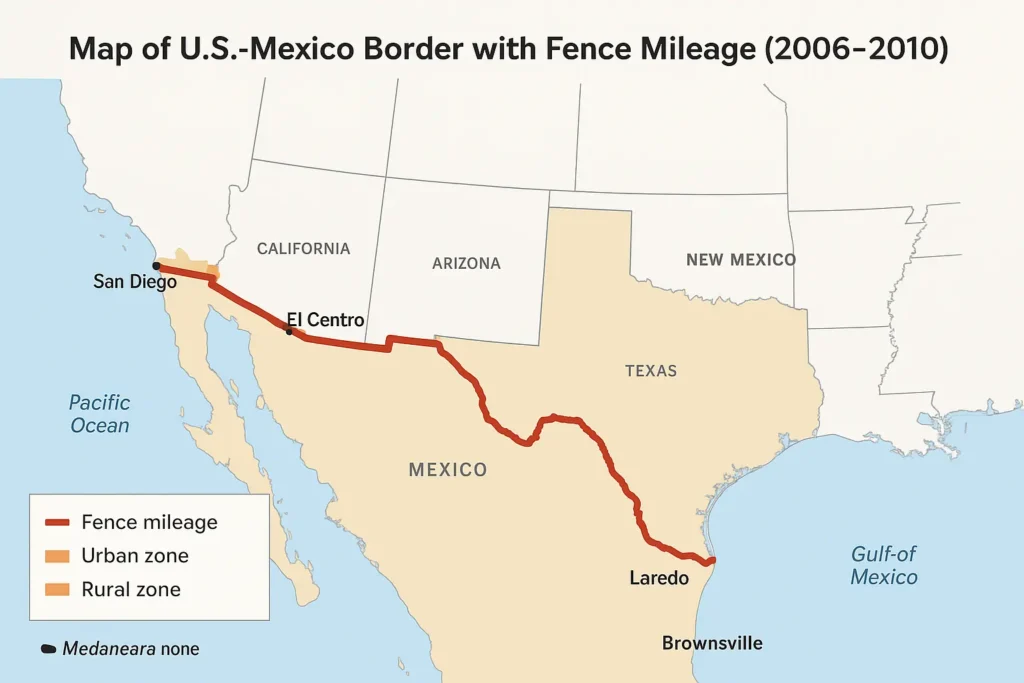
The Secure Fence Act: Origins and Policy Implications
To understand the Secure Fence Act of 2006, we must first examine the political, social, and security climate that led to its passage.
Rising Border Security Concerns Post-9/11
Since the 11th of September, 2001, terrorism attacks, national security is the key consideration of the U.S. government. The hijackers accessed the country through legal means, but officials feared that terrorists, drug dealers, and gangs might exploit the loosely-guarded borders. In 2002, the Department of Homeland Security (DHS) formed and took a dominant role in strengthening border enforcement.
The issue of illegal immigration became a controversial one by the middle of 2000s. Pew Research Data shows that about 12 million unauthorized immigrants lived in the U.S. in 2007, with many crossing the southern border. Citizens became more in favor of tighter border security.
Political Momentum and Legislative Push
In 2005, Border Protection, Anti-terrorism, and Illegal Immigration Control Act of 2005 passed in the House (H.R. 4437) would have constructed a 700 mile long double layered fence across the U.S. Mexico border. The Senate never passed this version, but lawmakers used it as a precedent when creating further laws.
In 2006 it seemed that a more measured approach had cross-party backing. Lawmakers reached a compromise deal and introduced the Secure Fence Act. After a vote of 80 to 19 in the Senate and 283 to 138 in the House, it enjoyed a wide, but not universal, consensus.
Key Fact: The Secure Fence Act was one of the few major immigration-related bills to pass Congress in the 2000s, highlighting its significance in a politically gridlocked era.
Key Provisions of the Secure Fence Act (2006)
Let’s break down the core provisions of the law and what it authorized.
- Construction of Physical Barriers
One of the act’s most prominent provisions allowed for the building of nearly 700 miles of barrier systems along the U.S.-Mexico boundary. This included:
- Double-layered fencing in high-traffic areas
- Pedestrian and vehicle barriers designed to prevent illegal crossings
- Fencing concentrated in urban corridors like San Diego, El Paso, and Tucson
Note: The act did not mandate a continuous wall from coast to coast, as is sometimes misunderstood. Instead, it allowed DHS to determine where fencing was “operationally effective.”
- Deployment of Surveillance Technology
In addition to physical fencing, the legislation prioritized advanced “smart border” solutions, such as:
- Radar systems
- Motion sensors
- Thermal imaging cameras
- Unmanned aerial vehicles (UAVs)
These tools aimed to enhance detection and response capabilities in remote areas where fencing was impractical.
- Increased Personnel and Infrastructure
The act supported the hiring of additional Border Patrol agents and the construction of new checkpoints, roads, and communication systems to improve operational efficiency.
- Environmental and Legal Waivers
Probably one of the most attractive points to the act was the allowance of the Secretary of Homeland Security to waive any federal, state or local law that might slow the process of construction. This included environmental policies, endangered species act and clean water act.
Source: DHS Legal Authority to Waive Laws for Border Wall Construction
The government used this waiver authority, derived from the REAL ID Act of 2005, over 50 times to bypass legal and environmental reviews.
Implementation and Progress: How Much Was Built?
Despite the ambitious 700-mile goal, the actual construction fell short due to logistical, legal, and financial challenges.
Mileage Completed by 2010
By 2010, during the Obama administration about 652 miles of fencing had been completed or reinforced– short of the mark. Although, less than 350 miles were new, two-layered obstacles; other structures were upgraded vehicle barriers.
Data Source: U.S. Government Accountability Office (GAO) Report, 2017
Cost and Funding
The fencing and the accompanying technology cost more than 2.3 billion dollars. Critics considered that the money had better been used instead on technology and people rather on buildings.
Geographic Distribution
Fencing was concentrated in:
- California (65 miles)
- Arizona (350 miles)
- New Mexico (29 miles)
- Texas (188 miles)
Notably, large stretches of the border—especially in ecologically sensitive or privately owned areas—remained unfenced.
Ongoing Debates: Assessing the Impact and Efficacy of the Secure Fence Act
While supporters hailed the act as a necessary step for national security, critics raised serious concerns about its effectiveness, cost, and ethical implications.
- Effectiveness in Reducing Illegal Crossings
Studies show mixed results:
- Border Patrol data indicates a decline in apprehensions in urban areas after the fence was constructed.
- But migrants tended to change paths to more inaccessible, risky areas- making them die in the deserts and rivers.
- The survey of RAND Corporation has shown that physical barriers on their own had limited long-term effect unless additional enforcement existed.
Quote: “Fences can be effective in specific locations, but they are not a substitute for a comprehensive immigration strategy.” – RAND Report, Evaluating the Effectiveness of Border Barriers
- Environmental and Humanitarian Concerns
- Wildlife Disruption: Frequently, the existence of jaguars, ocelots, and desert bighorn sheep habitats were ripped into parts by fencing structures.
- Water Flow Problems: Barriers changed natural drainage and created dangers of flooding to border towns.
- Human rights: Advocacy groups like Amnesty International railed against the action as posing a danger to the migrants and as a violation of humanitarian norms.
Source: Amnesty International – “USA: Fences and the Violation of Rights” (2008)
- Legal and Constitutional Challenges
- Several lawsuits diminished the waiver authority on the basis that they breached the National Environmental Policy Act (NEPA) and tribal sovereignty.
- Rodriguez, the court ruled in favor of the plaintiff on the basis of the precedent in Border Network of Human Rights v. According to Chertoff (2008), the waiver power was supported by the courts on the basis of national security.
- Political Polarization
The bill was one of many terms on the bigger debate immigration. Conservatives called it a move to take control; liberals cautioned it was an unfinished “short-term solution that disregards the source – economic disparities and visa violators.
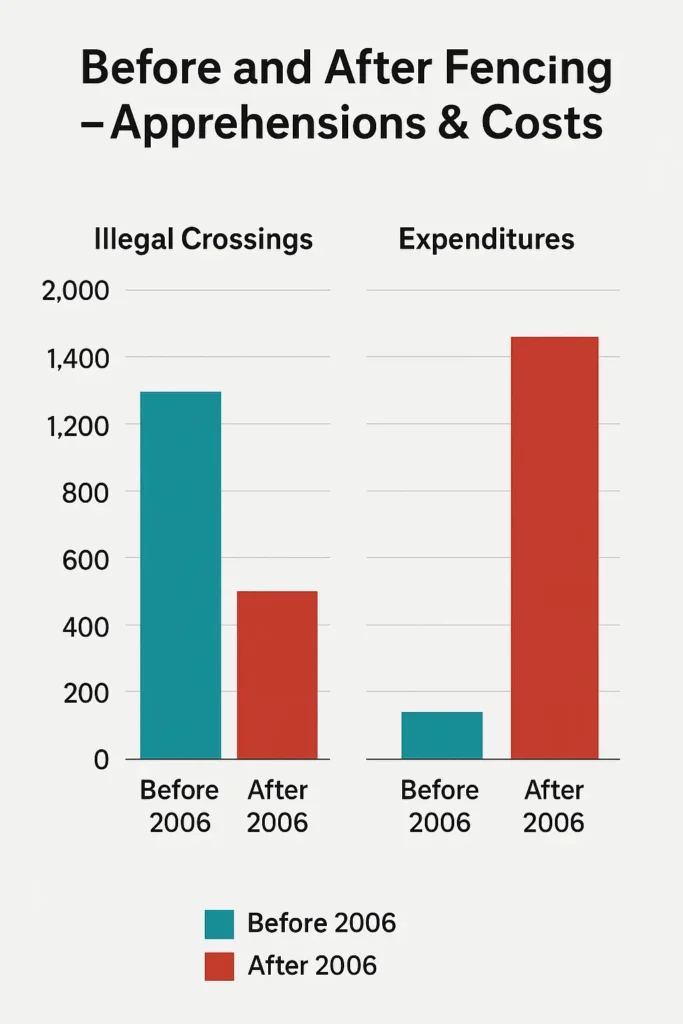
Secure Fence Act vs. Later Border Policies: Evolution of U.S. Strategy
The 2006 law set a precedent for future border security measures, including those under Presidents Obama, Trump, and Biden.
Barack Obama (2009–2017)
- Continued construction under the Secure Fence Act
- Shifted focus to interior enforcement and deportation priorities
- Invested in surveillance drones and biometric tracking
Donald Trump (2017–2021)
- Revised: Promised a comprehensive, reinforced barrier along the entire U.S.-Mexico border.
- Built over 450 miles of new or replacement barriers, many on existing Secure Fence Act foundations
Note: Much of Trump’s wall was not new construction but upgrades to pre-existing fencing authorized in 2006.
Joe Biden (2021–Present)
- Halted new wall construction
- Repealed Trump’s national emergency
- Focused on modernizing ports of entry and addressing root causes of migration
Despite these shifts, the infrastructure and legal framework from the Secure Fence Act remain foundational to current operations.
FAQ: Answering Real Questions
With the rise of voice-activated assistants like Alexa, Siri, and Google Assistant, optimizing for natural language queries is essential. Here’s how this article responds to frequently asked voice search queries:
Q: Who signed the Secure Fence Act?
A: President George W. Bush signed it into law on October 26, 2006.
Q: How much of the Secure Fence Act’s planned fencing did the government actually construct?
A: By 2010, the government completed about 652 miles of fencing, falling slightly short of the 700-mile goal.
Q: Why was the Secure Fence Act controversial?
A: Due to environmental damage, human rights concerns, high costs, and the use of legal waivers to bypass regulations.
Q: Is the Secure Fence Act still in effect?
A: Although the given building requirement ended, its precedents in construction and even the laws still affect the present policy of the borders.
Comprehensive Analysis: Broader Implications and Legacy
The Secure Fence Act was more than just a construction project—it was a symbolic and strategic turning point in U.S. border policy.
- Shift Toward “Layered Security”
The legislation introduced the concept of a “layered security approach,” integrating physical fencing, surveillance technology, and increased personnel to enhance border control. This model is now standard in border enforcement worldwide.
- Influence on Future Legislation
- Inspired later bills like the Border Security and Immigration Reform Act (2013)
- Established a legal foundation for future emergency declarations and budget repurposing.
- Highlighted the need for bipartisan compromise on immigration
- Public Perception and Media Coverage
The media often conflated the 2006 fence with Trump’s “wall,” leading to public confusion. Clarifying this distinction is crucial for informed debate.
- Economic and Diplomatic Impact
- Strained U.S.-Mexico relations, though both governments cooperated on anti-cartel efforts
- Cost estimates sparked debates over opportunity cost—could funds have reduced wait times at legal ports?
Conclusion: The Enduring Legacy of the Secure Fence Act
The Secure Fence Act of 2006 is considered to be one of the major turning points in the US border security policymaking. Although it failed to fix illegal immigration, it changed the physical and legal characteristics of the southern border. It showed Congress’s eagerness to get involved in security issues, the way lawmakers establish precedents in emergency powers, and how the national discussion recently re-emerged.
Since the arguments surrounding immigration reform, asylum policy, and the advancement of border technology are taking new turns, the experiences of the 2006 act are pertinent. We should not rely entirely on physical barriers—but when combined with effective enforcement, humanitarian protection, and diplomacy, they can form a constituent part of a balanced policy.
Whether you see the Secure Fence Act as a much-needed defense or as government overreach, it permanently altered the future direction of American immigration policy.

